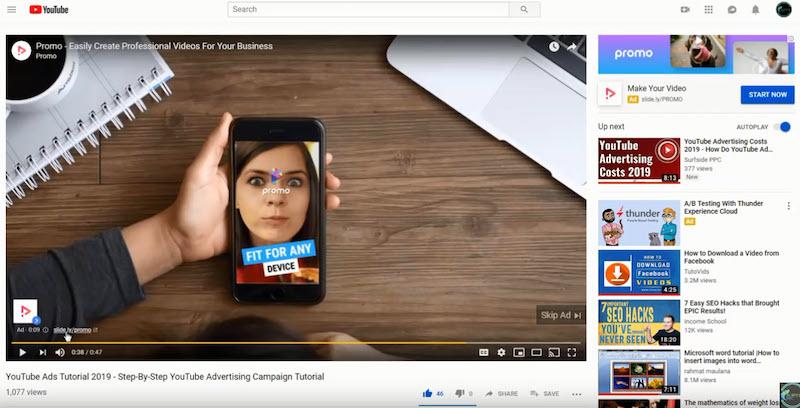Placement targeting for your YouTube ads can be one of the most precise targeting options in Google Ads. Note that I said “can be.” That's because if you are not fully aware of how placement targeting actually works within the campaign settings, you may think that placement targeting doesn't work at all. Also, your ads can appear on more placements than just YouTube channels and YouTube videos.
Image source
So in this post, I want to make sure everyone running video campaigns in Google Ads understands how the placement targeting actually works. I will cover:
- How to choose the right network for YouTube ad targeting
- How to choose the right YouTube ad placement type for your industry and ad goals
- How to add multiple additional placements to your ad group later on
I will also interweave these tips with common mistakes to avoid so you can plug leaks in your YouTube ad spend. Let's get started so you can feel more confident in your video ad placement selections and get maximum results through your YouTube ad targeting.
Selecting the right network for your YouTube ad targeting options
Before I go over specific YouTube ad targeting options, I do want to go over a very important first step within YouTube ad campaign setup: network selection. In the accounts I work with, this is where I see a lot of confusion between where people think their ads are showing up versus where the ads actually show up. It's important to select the right network for your targeting options because otherwise, your YouTube ad placements can get “misplaced.” In the image below, you can see every place your YouTube ads can be shown. This includes: Youtube search results, YouTube videos, and Video partners on the Display Network:
Youtube search results
One of the network placements that you can select is just the YouTube search results. Remember, YouTube is the second largest search engine after Google, and we can place video ads on top of the YouTube search results page. However, you can only choose this network targeting option if you are running TrueView discovery ads.
YouTube videos
Now the most familiar form of placement targeting for YouTube ads is placing them on specific YouTube channels and pages. This form of placement targeting can be used for both in-stream and discovery ad formats.
Video partners on the Display Network
If you want to expand your “Youtube videos” network section within your campaign settings, be sure to check box underneath that says “Video partners on the Display Network.” This will expand your reach and get more eyeballs on your video ads by enabling your video ads to appear on video partners on the Display Network. If you hover over the question information symbol, you can read more information about this option from Google Ads. This is letting us know that Google has the right to extend the reach of our video ads to specific websites and apps that are part of the Google Display Network.
As you can see, when I uncheck the YouTube videos box, I cannot select just video partners. But if you do choose to show your ads on video partners in the Display Network, your ads will still also appear on YouTube.
Choosing your placements for optimal Youtube ad targeting
Still within the campaign settings, scroll down to the section where you can create your ad group. Here I will go over the options you have for your YouTube ad placement targeting. Let's begin by setting up an ad group when creating our campaign. To find the area where we can start selecting placements, find the Content section, then choose the Placements option which lives alongside the Keywords and Topics targeting:
As I said in the intro, your ads can appear on more placements than just specific YouTube channels or YouTube videos. I am going to go over each of the placement options and show you a few ways that you could research what type of placements you can add for your video campaigns in Google Ads. I'm a big baseball fan, so I'm going to use baseball as my research source for the rest of this post.
YouTube channel placements
If you have specific channel placements in mind, you can easily search for them. In this example, it makes complete sense for me to want to get my video ads on the actual baseball league channels. All I have to do is type in some keywords, then select the YouTube channels options.
When scrolling through the results, I get the number of videos that each channel has as well as their total number of subscribers. This gives me an initial idea of the type of reach that my video ads can get by using this specific placement targeting.
YouTube video placements
Sometimes when researching channels, you may find that only certain videos on that channel are relevant to your targeting audience. I can use the same search feature to look for YouTube videos that are relevant to my keywords instead of channels. I will then get a view of which channel the video is from as well as the number of views the video has received.
What is interesting about this image, and I can only speak from the date I'm writing this post, is that the videos I'm seeing are fairly recent. A lot of the videos in this search are actually from games that happened yesterday. I have seen this happen a lot with certain industries or certain themes of videos where the content is constantly updated. Depending on the industry, you may have to research harder for some than others if you are looking to find video content that is a little bit more evergreen.
Video lineup placement targeting
The next placement targeting option, video lineups, is the newer one to the mix. As of right now, video lineups have a set 137 options that you could choose for targeting. The name of this placement targeting option speaks for itself. Think of it as how we used to say the TV lineup for a particular channel. Video lineups have really come about because of all the YouTube viewership that has shifted to TV devices. We can now go after specific themes of video content as you can see in the image below.
The first option that shows up at the top is popular content worldwide. If you just want to have brand awareness and you want your videos to be placed on what is trending on YouTube at the time, this is now one of the new selections that you can add to your video campaigns. Besides popular content, we can see very specific topics that are part of these video lineups, as well as the countries that these lineups belong in. Just a few examples include:
- Comedy
- Video games
- Cars
- Beauty
- Cooking
- Music
- Toys
- Gadgets
- Sports
- TV Genres
- Plenty of others including subcategories under the ones I mentioned.
Website placement targeting
With website targeting I can type in specific URLs and also use keywords to see results of websites that are part of Google's Display Network. In the image below, I just typed in baseball. It is extremely important that you understand that these are all websites that are part of Google's Display Network. Now what Google does not tell you is that just because these websites are part of the Display Network, it does not mean that these websites have video ad placements. This is where I've seen accounts waste a ton of money.
As you can see above with the selection options, there's a short text explanation on how these placements may appear, but it's still kind of vague. If you do, however, go to the Google Ads help page on targeting options for video ads, you can get more details on what this notification means. Google lets advertisers know that when you add Google Display Network placements, your ad may still run on all eligible locations on YouTube and vice versa.
Knowing the fine print, I have seen some that accounts I have worked on were only targeting specific websites. Those websites actually did not have any video ad space, or that client was not bidding high enough to be eligible to show up on those specific website placements. What happened was the placement targeting was ignored, and Google then looks at any other safety net targeting options that you have layered on to that specific ad group. I have seen very specific placement targeting get ignored, and then video ads shown only on broader targeting like affinity audiences or topics. So make sure you are still monitoring your placement reports very closely after launching any website placement targeting ad groups.
App and app category targeting
You can also search for apps that you may want to have your video ad shown on. In my case, I see a lot of very specific baseball apps, but you may want to go to these specific app stores and review each of the app placements to see if it's worth having your video on any of these specific apps. Right now all I am seeing are games, and that may not be where I want my video ad to be shown.
The last option is app categories, and there are only 141 specific categories to choose. App categories are going to be much higher-level categories. For example, the closest thing to baseball for me would just be overall sports. So most likely in this example I may think that is too broad, but app categories can really be beneficial for expanding reach.
Entering multiple YouTube ad placements at once
Maybe before you even started creating your video campaign, you already did your research. You already found specific channels, videos, etc. for where you wanted your video ad to be shown for maximum profitability. While you are doing any proactive research, start saving all of those URLs because it will be a lot easier to add them to your ad group later on whenever you are ready to create the ad group. We can do this by clicking on the “Enter multiple placements” option.
You can literally take your list of URLs, paste them into the placement field, and add all the placements that you pasted over to your selections column. Within the matter of seconds, you can upload a list of every single placement that you would want to be a part of, and that can make the ad group creation go a lot quicker.
Gain confidence to make the right Youtube ad targeting decisions
As you can see, no matter how specific you think Youtube ad placement targeting is, it's not perfect. It's important to understand how the campaign settings work in regards to where your ads can actually appear. This will empower you to know what you are selecting for your placement targets and how they can actually affect who's actually going to see those ads; and will also ensure that the next YouTube ad placement targeting ad group or campaign you run gets off to the best start as possible.















Recent Comments